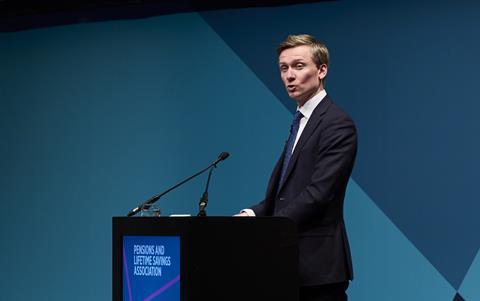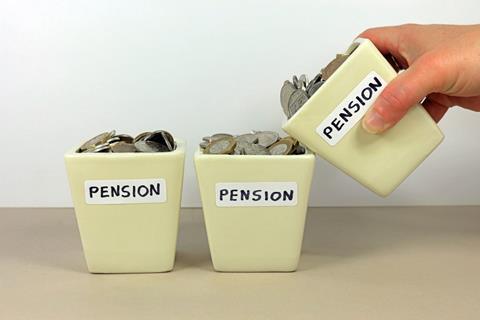Pension pots worth less than £1,000 will be automatically consolidated into a “high performing” pension fund under plans unveiled by the government this morning (24 April).
The Pension Schemes Bill, set to be introduced later this year, will include a proposal to automate the consolidation of small pots into approved pension schemes. It follows work by the cross-industry Small Pots Delivery Group.
Pension schemes will have to be able to facilitate automatic consolidation from 2030 under the proposals.
Pensions minister Torsten Bell claimed the move could “boost the pension of an average earner by around £1,000”.
“This is the starting point for future of workplace pension pot consolidation, providing the foundations for consolidating greater numbers of larger pension pots.”
Torsten Bell, pensions minister
The government now plans to work to “ensure that the deferred small pots which are currently plaguing the workplace pension market are eliminated – supporting a more efficient and effective landscape where saver outcomes are at the heart of decision making”, the minister said.
Tackling the small pots problem
The government estimates that there are approximately 13 million small pension pots, defined as deferred pots worth less than £1,000.
Automatic enrolment has led to a proliferation of small, deferred pots as people change jobs more often. Each of these has a charge, meaning individuals are paying fees to multiple providers. Small pots are also relatively costly to administer – the government estimates that it costs the industry £225m to oversee these accounts.
The admin cost of small pots
Quilter estimates that it costs approximately £20 a year to administer a deferred pension pot. An annual charge of 0.4% would mean that a £1,000 pot charges a fee of £4 – far below the administration cost.
“For pension providers, dealing with small pots, especially those with less than £1,000, is inefficient and can result in financial losses due to administrative costs,” said Jon Greer, head of retirement policy at Quilter.

Bell said the government planned to consolidate small pots into “one high performing pension, reducing costs as well as hassle for savers”.
According to the Small Pots Working Group, which published a report into the consolidation initiative today, delivering this aim would require the creation of a “data platform” to help identify pots that can be consolidated and match them to the right people. The group’s report recommended learning from the development of pensions dashboards technology to facilitate secure data sharing.
The working group also set out a proposed framework for authorising consolidator schemes. This would be an existing auto-enrolment pension scheme, likely a master trust, with the ability to scale up and provide “good value for money for their members” as well as protection from flat-fee charges.
The Financial Conduct Authority may have to establish a separate, parallel regime for contract-based pension schemes such as group personal pensions. The working group’s report said there was a “lower appetite” to use such arrangements as consolidators.
People would be able to opt out of consolidation if they wanted to, the report said.
The proposals will now be subject to a “feasibility review”, led by the Pensions and Lifetime Savings Association (PLSA). This will look in detail at potential operating models for the data platform, including cost analysis and risk assessments.

The ‘starting point’ for consolidation
“This is the starting point for future of workplace pension pot consolidation, providing the foundations for consolidating greater numbers of larger pension pots,” Bell said in his introduction to the Small Pots Delivery Group’s report.
The minister added that he would provide more detail about “sequencing and timing” over the coming months to help the industry implement the many changes expected through the Pension Schemes Bill and the Pensions Review.
“I look forward to our continued partnership with the pensions industry as we move together on this journey, to support savers to achieve the best possible retirement outcomes,” he said.
“The accumulation of small pots creates unnecessary cost and complexity for savers and schemes alike. The PLSA… supports the model being proposed by the government.”
Zoe Alexander, PLSA
Gaucho Rasmussen, executive director of regulatory compliance at the Pensions Regulator, said: “Having lots of small pension pots erodes value and makes retirement decision-making difficult. We welcome steps to solve the problem and will support government and industry to make these plans a reality.”
Zoe Alexander, director of policy and advocacy at the PLSA, said: “The accumulation of small pots creates unnecessary cost and complexity for savers and schemes alike. The PLSA has worked extensively with industry and the Department for Work and Pensions to propose solutions and supports the model being proposed by the government.”
Gail Izat, workplace pensions director at Standard Life, added: “The number of small pots in the system is growing at a rate of knots and ultimately heightens the risk that people will lose track of their hard-earned savings.
“The introduction of consolidators that can administer these pots effectively and invest them dynamically will be a step forward and when combined with pension dashboards will empower people to take control of their savings.”
Legacy technology a ‘significant challenge’ ahead
Jonathan Hawkins, propositions lead at technology firm Bravura, said the report was “an important step towards modernising the UK’s outdated pensions infrastructure and simplifying pensions management for millions of savers”.

“As retirement patterns continue to change, the efficient management of smaller pension pots will have huge implications for UK citizens, particularly for those with more transient jobs or careers,” he said.
As well as reducing administration costs for some providers, Hawkins said the changes would “expose those operating on legacy technology who will face significant challenges in managing this transition”.
“The importance of embracing open infrastructure capable of automating the full lifecycle from onboarding to consolidation and ultimately drawdown, cannot be underestimated,” he added. “Failing to do so means providers running legacy tech will struggle to effectively automate these new processes, especially when dealing with incomplete or imperfect information. This is particularly critical given the scale of the task.”
A £1,000 pension boost?
The pensions minister claimed that the consolidation reforms could boost the average earner’s pension pot by £1,000. This was based on a case study in the Small Pots Delivery group’s report, which modelled an 18-year-old male earning the UK median wage and contributing to a pension scheme until state pension age.
Consolidation should help reduce administrative costs for pension providers, savings that the government expects to be passed on to pension savers. Assuming cost reductions of two basis points for savers, the government said consolidation of small pots would add around £935 to a median-earning male’s total pension savings.






















